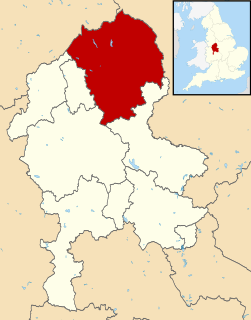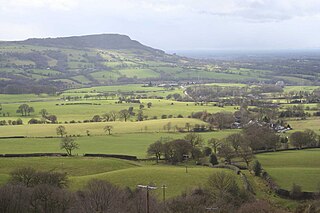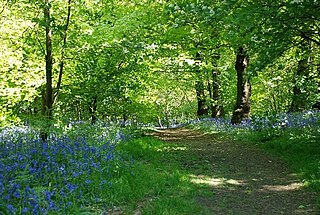
In folklore, a mermaid is an aquatic creature with the head and upper body of a female human and the tail of a fish. Mermaids appear in the folklore of many cultures worldwide, including the Near East, Europe, Asia, and Africa.

Leek is a market town and civil parish in the county of Staffordshire, England, on the River Churnet. It is situated about 10 miles (16 km) north east of Stoke-on-Trent. It is an ancient borough and was granted its royal charter in 1214.

The Roaches is a prominent rocky ridge above Leek and Tittesworth Reservoir in the Peak District of England. The ridge with its rock formations rises steeply to 505 m (1,657 ft).

Staffordshire Moorlands is a local government district in Staffordshire, England. Its council, Staffordshire Moorlands District Council, is based in Leek and is located between the city of Stoke-on-Trent and the Peak District National Park. The 2001 census recorded the population as 94,489.

Longnor is a village in the Staffordshire Peak District, England. The settlement dates from early times, the first recorded church building being in the Middle Ages. The village was named Longenalre in the Domesday Book. Located on a major crossroads, Longnor was a significant market town in the 18th century. It lies on the north bank of the River Manifold, on a limestone ridge between the Manifold and the River Dove.

A kettle is a depression/hole in an outwash plain formed by retreating glaciers or draining floodwaters. The kettles are formed as a result of blocks of dead ice left behind by retreating glaciers, which become surrounded by sediment deposited by meltwater streams as there is increased friction. The ice becomes buried in the sediment and when the ice melts, a depression is left called a kettle hole, creating a dimpled appearance on the outwash plain. Lakes often fill these kettles; these are called kettle hole lakes. Another source is the sudden drainage of an ice-dammed lake. When the block melts, the hole it leaves behind is a kettle. As the ice melts, ramparts can form around the edge of the kettle hole. The lakes that fill these holes are seldom more than 10 m (33 ft) deep and eventually become filled with sediment. In acid conditions, a kettle bog may form but in alkaline conditions, it will be kettle peatland.

The Caldon Canal, opened in 1779, runs 18 miles (29 km) from Etruria, in Stoke-on-Trent, to Froghall, Staffordshire. The canal has 17 locks and the 76-yard (69 m) Froghall Tunnel.

Rudyard Lake is a reservoir in Rudyard, Staffordshire, located north-west of the town of Leek, Staffordshire. It was constructed in the late 18th century to feed the Caldon Canal. During the 19th century, it was a popular destination for daytrippers taking advantage of easy access using the newly constructed North Staffordshire Railway. The lake is still used for many water activities such as boating, canoeing, fishing and also for walks and recreational steam train trips.

Delamere Forest is a large wood in the village of Delamere in Cheshire, England. The woodland, which is managed by Forestry England, covers an area of 972 hectares making it the largest area of woodland in the county. It contains a mixture of deciduous and evergreen trees.

Spy Pond, also known as Spie Pond in the 17th & 18th centuries, is a 103-acre (0.42 km2) kettle hole pond located near the heart of Arlington, Massachusetts, adjacent to the Minuteman Bikeway.

Semerwater is the second largest natural lake in North Yorkshire, England, after Malham Tarn. It is half a mile long, covers 100 acres (0.40 km2) and lies in Raydale, opposite the River Bain. A private pay and display parking area is at the foot of the lake.
A mere is a shallow lake, pond, or wetland, particularly in Great Britain and other parts of western Europe.

The Cloud or Bosley Cloud is a prominent hill on the border between Cheshire and Staffordshire a couple of miles west of the Peak District National Park boundary.

Iara, also spelled Uiara or Yara or Mãe das Águas, is a figure from Brazilian mythology based on ancient Tupi and Guaraní mythology. The word derives from Old Tupi yîara = y ("water") + îara = "lady of the lake". Depending on the oral tradition and the context of the story, she can be seen either as a water nymph, a siren, or a beautiful mermaid that lives in the rivers of the Amazon Basin.

Kitch-iti-kipi is Michigan's largest natural freshwater spring. The name means "big cold spring" in the Ojibwe language. It is also sometimes referred to as the Big Spring. Kitch-iti-kipi, or "Mirror of Heaven" as it is referred to today, was originally given that name by the Ojibwe.

The Loe, also known as Loe Pool, is the largest natural freshwater lake in Cornwall, United Kingdom. The earliest recorded appearance of this simple name form was in 1337, when it was called "La Loo", but is mentioned as 'the lake' in 1302; Situated between Porthleven and Gunwalloe and downstream of Helston, it is separated from Mount's Bay by the shingle bank of Loe Bar. Both the Loe and Loe Bar are situated within the Penrose Estate, which is administered by the National Trust, and are designated as a Site of Special Scientific Interest by Natural England. It is within the Cornwall Area of Outstanding Natural Beauty and is considered a classic Geological Conservation Review Site. The South West Coast Path, which follows the coast of south-west England from Somerset to Dorset passes over Loe Bar.

Rostherne Mere is a natural lake in Cheshire, England. It is the largest of the Cheshire meres with an area of 48 hectares and a maximum depth of 30 metres (98 ft). It lies north of Rostherne village and south of the M56 motorway. Because of its importance for wildlife, the lake, together with neighbouring areas of woodland and pasture, has been declared a national nature reserve, a Ramsar site and a Site of Special Scientific Interest covering 152.9 hectares.

A double sunset is a rare astro-geographical phenomenon, in which the sun appears to set twice in the same evening from a specific viewing-point. Such phenomena may have been regarded as significant in prehistoric times, and double sunsets have been discussed in the context of archaeoastronomy by researchers such as Alexander Thom.
Sir Thomas Wardle was a British businessman, known for his innovations in silk dyeing and printing on silk. He collaborated with the designer William Morris, who visited his dyeworks in Leek, Staffordshire to learn how to use natural dyes. He was knighted by Queen Victoria for his services to the silk industry.

Saltwells Local Nature Reserve is situated in the Netherton area of Dudley Metropolitan Borough in West Midlands, England. The reserve, created in 1981, covers 247 acres and includes Saltwells Wood and part of Netherton Hill within its boundaries. The reserve encloses two Sites of Special Scientific Interest and one scheduled ancient monument.



















